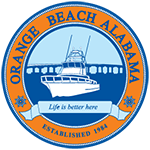
Rules from the City of Orange Beach
The City of Orange Beach is the municiple steward of Robinson, Bird, and Walker Islands. Below are some key rules that the City of Orange Beach Parks and Recreation Department have estabilshed for using them:
1. No glass of any kind.
2. Please bring trash bags and remove when you go.
3. No dogs or pets are allowed on the islands or in the surrounding waters.
4. Do not access the interior of Robinson Island or Bird Island due to protected shorebird nesting sites.
5. Don't pick the Sea Oats - they are essential to the eco-system of the islands.
6. Be considerate of others - keep the sound down on stereos.
7. 'No Motor Zones' are posted on the east side of the islands. This is to protect important grass beds.
8. The southern tip of Bird Island is the best area for landing personal watercraft and small boats.
One of the awesome things about our islands is that, while they are all connected in terms of habitat and location, each one has its own unique addition to the channel. That being said, it is also true that each island has its own set of challenges for us to work through. Below is some specific information about each island:
Bird Island, one of the main islands in the channel and part of the migratory flyway for our tropical song birds, is home to the Least Tern. This fascinating little bird is unique in that it actually nests on the ground. This island, being one of its homes, especially benefits from people - and their dogs! - not traveling to the interior, green parts of the island. Their eggs are easily, unknowingly destroyed by invaders just trying to explore the beautiful island.
Be careful with these little neighbors of ours and do not let your dogs wander around the fenced off parts of the island. These areas have been blocked off to protect these and other species of animals that make these islands their home.
Robinson Island, on the left in the picture above, is a long time home to the Great Blue Heron! This long time neighbor of the locals finds much safety on this little home island off the main land. With recent disasters, including Hurricanes Ivan and Katrina, as well as the Deepwater Horizon Oil Spill, this island is struggling to support that population. While we are working to replace natural habitats (2000 pine trees!), we are also constructing and placing heron nests around the island throughout the year.

Bird Island

Robinson Island
Navigate the Isles
Below are the different ways the community has reached out to care for these islands. We love our time there, and want everyone to have that same opportunity!

Rabbit Island
The eastern most island is Rabbit Island. Owned by The Nature Conservancy, this is the largest, and wettest, of the islands. There are many different areas of important sea beds and habitats in and around this island, so it is advised that boaters and visitors be careful and keep to any regulation signage on and around the island in terms of wake zones and speed limits.

Gilchrist Island
Gilchrist Island is privately owned and not available for public use. This island is the western most located island, at the mouth of Cotton Bayou.
Walker Island
Walker Island has been newly acquired by the City of Orange Beach. This active, new island has a large variety of water fowl, especially various types of ducks. Keep an eye out for educational signage explaining the best ways to keep this island thriving with life.
By hosting these different species of fowl and sea grasses, Walker Island is an important part of the habitat that all five islands create. Damaging or reducing this island will impact the other four by decreasing their ability to sustain life.
